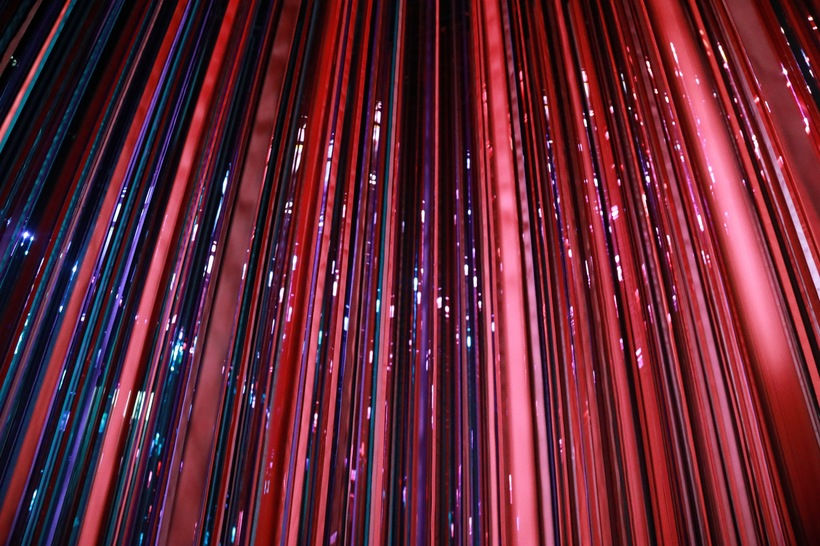Please Do Touch the Art: What is the Taste of the Color Blue, at BBAX

Synaesthesia: What is the taste of the color blue?
All art-making tackles the unruly prospect of finding an external form for a private vision, thereby offering audiences a fresh, unique perspective on the world — and in the process prompting the viewer to examine assumptions about their own point of view. In the case of the current exhibition at Building Bridges Art Exchange, the artists and organizers are taking this aspect of how art functions quite literally, to a surprising new level. Synaesthesia: What is the taste of the color blue? at Building Bridges now through November 25, presents an interdisciplinary examination of the synaesthetic experience.

I raised to my lips a spoonful of the tea in which I had soaked a morsel of the cake. No sooner had the warm liquid mixed with the crumbs touched my palate than a shudder ran through me and I stopped, intent upon the extraordinary thing that was happening to me. An exquisite pleasure had invaded my senses, something isolated, detached, with no suggestion of its origin. And at once the vicissitudes of life had become indifferent to me, its disasters innocuous, its brevity illusory - this new sensation having had on me the effect which love has of filling me with a precious essence; or rather this essence was not in me it was me. I had ceased now to feel mediocre, contingent, mortal. Whence could it have come to me, this all-powerful joy? I sensed that it was connected with the taste of the tea and the cake, but that it infinitely transcended those savours, could, no, indeed, be of the same nature. Whence did it come? What did it mean? How could I seize and apprehend it? — Marcel Proust, Remembrance of Things Past


Synaesthesia a genetic neurological trait, affecting nearly 4% of people, usually described as a cross-firing among and between the senses, which trigger each other in all combinations. It adds rather than replaces, so the non-synaesthetic brain for example sees blue and only sees blue — where the synaesthetic sees blue and perhaps also tastes salt, or feels cold, at the same time, as part of the experience of blue. Sounds may generate tastes, and of course as Proust has taught us, taste and indeed any sense, may also uncover the most profound, unbidden memories. This unique category of intersectional sensory experience is of obvious value to artists. Translated into directness, the arts are suited to show rather than tell, and in some cases reenact, and even impart, or transfer. There’s a lot of interactivity in the Building Bridges galleries, and way more scientists than usual.


The show’s range of experiential configurations include video, sculpture, installation, projection, design, performance, sound, taste, texture, text, sciences, and scent in varying interactions and layers. Anne Patterson leverages her background in theatrical design to embrace the environmental, immersive, and architecturally engaged potential of intersensorial perception. Her art reaches out to more than one sense at a time, approximating the real simultaneity of life as it is lived. James Wannerton’s map of London offers a seemingly ordinary guide to his daily experience, yet in transposing sound, taste, and place posits a whole new way to experience the familiar world. Tim Thompson combines warm interface design, woodworking, and MIDI-based super-tech in an interactive digital symphonic sculpture that looks and feels like you’re driving the TARDIS and playing the theremin at the same time, which you basically are.

Marjan Vayghan’s multiplatform, performative installation curiously succeeds at imparting a kind of contagious synaesthesia, the imprinting of her personal memories, at times emotionally charged and intensely dark, onto the consciousness of her audiences, via an inviting taste-based experience. She essentially reverse-engineers a collective Proustian moment that lingers in its new host. Marcos Lutyens has long pursued alternative contours for a visible social practice, and his installation exists as a colorful, tactile sculptural installation but importantly is experienced blindfolded by touch on hands and feet, results in part from an online survey in which he asked participants to equate color and shape with emotional and psychological states. In the gallery, they are asked to feel those emotions inside the energy the colors transmit to the brain, not through the eye but the skin. These are just a few of the transformative art-based experiences waiting to be activated by your presence.

It is plain that the truth I am seeking lies not in the cup but in myself. I put down the cup and examine my own mind. It alone can discover the truth. But how: What an abyss of uncertainty, whenever the mind feels overtaken by itself; when it, the seeker, is at the same time the dark region through which it must go seeking and where all its equipment will avail it nothing. Seek? More than that: create. It is face to face with something which does not yet exist, to which it alone can give reality and substance, which it alone can bring into the light of day. —MP

The International Association of Synaesthetes, Artists, and Scientists (IASAS) present this exhibition in partnership with the ArtSci Gallery at UCLA.
ARTISTS: Jon Adams - Raewyn Turner & Brian Harris - Anne Patterson - James Wannerton - Appelusa - M.J. Cordoba - Marjan Vayghan - Tim Thompson - Christine Söeffing - Marcos Lutyens in collaboration with Dr. Richard E. Cytowic





















